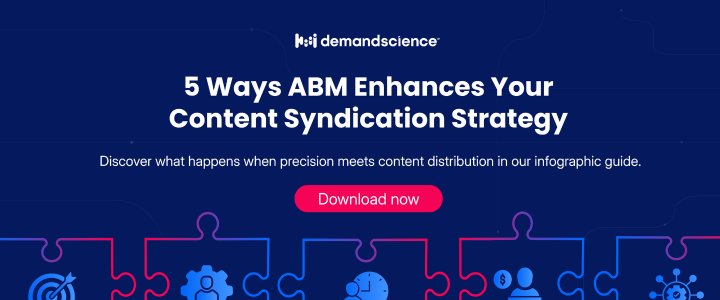
A strategic ABM campaign integrates account-focused elements into the creation of buyer-centric content that boosts overall inbound marketing initiatives. Ninety-eight percent of marketers already use or are planning to use an ABM strategy. Although soaring impressions are no guarantee of engagement or conversions, with quality content that resonates and targets client needs and pain points, marketers can turn the tables.
Developing valuable content that addresses the needs of buyers and strategically distributing them to target accounts adds a complementary inbound element to ABM’s more apparent outbound strategies.
This is where ABM and content syndication as complementary strategies come in. The two strategies combine to create an effective, hyper-targeted strategy to generate and nurture only the highest-quality leads among your ideal customer accounts.
Content syndication is, according to research from Activate Marketing, the fastest-growing channel for B2B tech marketers. Let’s explore how it performs when paired with account-based marketing, and how they come together to deliver significant benefits to marketing teams, including better personalization, greater content ROI, more accurate data, and improved nurturing throughout the customer journey.
Leveraging ABM Lists for Content Syndication
When you have great and valuable B2B content in hand, it is incredibly normal to think of blasting it out. Content marketing and distribution work in tandem, after all. The more people it reaches, the higher the chances of engagement, right? But while broader reach sounds great, a “spray-and-pray” method may not always yield the best results. In some cases, disseminating your content to an overly broad audience can actually be counterproductive and wasteful, especially when it comes to lead nurturing.
This is where personalization plays a crucial role in the effectiveness of your outreach. The content you create is likely to resonate most strongly with a small, specific audience rather than a general one. This is where the concept of leveraging ABM lists for your syndication efforts comes into play—rather than blasting your content out to everyone, you should consider syndicating it to a smaller, more targeted audience that is more likely to engage with it meaningfully.
How ABM hyper-targets lead gen and nurturing
ABM is a highly targeted marketing strategy that involves focusing your efforts on a specific but dynamic list of target accounts or companies that you’ve identified as “best fit” to be your potential customers.
As opposed to a marketing strategy that’s all about generating a large volume of leads, ABM prioritizes quality over quantity. An ABM campaign is tailored to address the precise concerns and pain points of your target account, and the different members of the buying committee you’ll reach with your personalized content and messages.
Think of ABM as hosting an exclusive dinner party. Every invitee is hand-selected, their dietary preferences are researched and taken into consideration, and a carefully plotted seating chart encourages the most stimulating conversation. By contrast, a general brand marketing campaign is akin to posting a flier to a block party, where there’s no filter if everyone who is coming is actually qualified to do so.
Both strategies could work, but one takes a lot more planning and consideration of the perfect guest list. That’s ABM.
Account-based marketing starts with marketing and sales coming together to build an ABM list of target accounts. Your ABM list should zero in on the most qualified leads that fall into your organization’s ideal customer profile (ICP) with the potential to bring in significant revenue for your company. Your marketing team and each account’s sales representatives work together. They conduct thorough research to focus on sending consistent, personalized messages to specific contacts. This helps your team focus resources on deals that are most likely to close. This makes ABM a proven way to generate qualified leads and boost conversion rates. Also, your ABM list should be dynamic, and continuously updated with the most qualified leads that fit your organization’s ideal customer profile (ICP).
Read: Account-Based Marketing: Guide to Innovative Lead Targeting
Syndication as a data-driven approach to content distribution
In B2B marketing, content syndication involves republishing your existing content on other websites, sharing it on social platforms, and promoting it across syndication networks. Syndication takes the power of content marketing and applies data-driven insights to multiply your reach to your target audiences across the internet.
However, to truly maximize content syndication, you need to ensure that your valuable content reaches the right audience. A highly targeted and data-driven syndication campaign is achievable with the right syndication partner, one that offers robust data.
With DemandScience, our science-backed content syndication solution operates on our robust data ecosystem with millions of verified contacts. Our client partners leverage buyer and intent data to do their campaign targeting, generate marketing-qualified leads, and deliver vetted leads to sales teams.
Read: Everything You Need to Know About Content Syndication
How ABM and content syndication work together
Now, let’s put these two data-driven marketing strategies together. What happens when you integrate ABM strategies and content syndication together?
ABM content syndication allows you to connect with your target accounts on a granular level. With a content syndication partner, you’ll be able to access and benefit from multiple layers of customer data to zero in on the companies and individuals you’d most like to build relationships with. More data and greater reach from syndication and more targeted audiences from ABM add up to a powerfully efficient lead generation and nurturing engine.
ABM and content syndication together allow you to concentrate your efforts on building and nurturing relationships with key accounts, rather than spreading yourself too thin by trying to win over just anyone. By syndicating your content specifically to target accounts, you can reach segments of the buying group that you may not already be in contact with. As you may already know, the B2B sales process involves a multitude of stakeholders, and ABM is laser-focused on understanding that buying group. It aims to grow rapport with each member, ensuring that your message resonates with the right people at the right time.
When you share high-quality content with tertiary decision-makers at your target accounts, you create an opportunity for them to influence the primary decision-makers in favor of your business. This is a critical aspect of ABM: getting in front of as many members of the buying group as possible and guiding them toward a favorable purchase decision.
An example of ABM-content syndication targeting
Say you have an ABM list of 50 mid-size companies that you’ve identified as your top target accounts within your ICP. You’ve used technographic data and intent data to confirm that your product, a data quality monitoring tool, fits a gap in their current tech stacks and integrates with their existing software. The buying committee for a solution like yours includes key executives. This group has CDOs and CTOs. It also includes decision-makers like VPs of engineering. Influencers in this group are senior data engineers, data governance specialists, and data scientists.
And you’ve created tailored content to address the questions and pain points that will arise at every step, for every member of the buying committee, such as:
- Executive thought leadership on the potential business consequences of poor data quality
- Industry-specific whitepapers on the technical challenges surrounding data quality
- How-to videos on data quality testing
- Customer webinars highlighting your solution’s transformative impact at similar companies

Benefits of combining ABM and content syndication
Let’s break down exactly how these two marketing strategies work together to generate and nurture the highest-quality leads for your organization.
Improved personalization
When you couple ABM and content syndication, you are committing to a laser focus on reaching your most valuable prospects with the most relevant content.
ABM is all about gaining a deep understanding of your highest-priority accounts and using that information to hyper-target your marketing and sales efforts. That means customizing buying journeys for every account, taking their firmographic, technographic, and all other available data into consideration. You’ll be able to pinpoint the exact challenges a company is likely to encounter in their industry, at their growth stage, with their specific product or service offering, and using their exact technology stack.
Increased ROI of your valuable content
Generating the most value from your content is always a win. But with ABM, it’s a huge challenge because the content you create for these targeted campaigns will, by nature, always be highly personalized and most relevant to a microscopic audience.
In most cases, promoting highly personalized content to broad audiences wouldn’t make sense. But with ABM content syndication, you can republish it in highly targeted ways to extend your reach and improve your account penetration.
Better nurturing for your target accounts
ABM is a long game played across multiple channels. These high-value accounts often have long, complex buying journeys, and different individuals will conduct their own research for weeks or months before they ever speak to a sales representative. That’s why it’s important for your brand to stay visible and connect with leads over time. You need to reach your target contacts with the right information at the right stage of their buying journey and on the right channel.
Read: Guide to Nurturing Content Syndication Leads
Final words
ABM and content syndication are powerful strategies that use customer data to reach contacts with relevant content, improving your overall marketing ROI. By integrating these two strategies, companies can unlock a new level of hyper-targeted outreach to generate and nurture high-quality leads along every stage of the customer journey. ABM and content syndication allow you to concentrate on key accounts and engage with the right stakeholders. With this approach, you can build stronger relationships, increase account penetration, and ultimately drive more successful outcomes in your ABM efforts. Remember, quality over quantity is the name of the game when it comes to effective content marketing in the B2B landscape.










